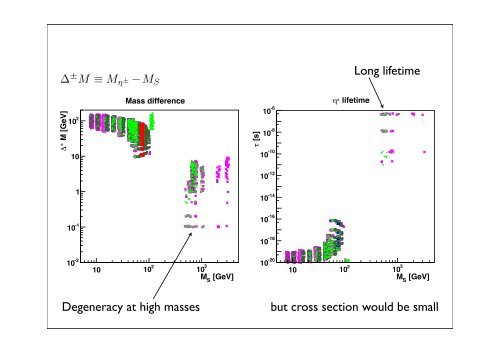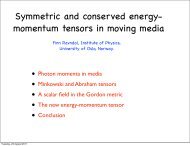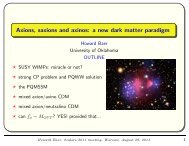The CP-violating inert-doublet model - Scalars 2011
The CP-violating inert-doublet model - Scalars 2011
The CP-violating inert-doublet model - Scalars 2011
Create successful ePaper yourself
Turn your PDF publications into a flip-book with our unique Google optimized e-Paper software.
-18<br />
10<br />
3<br />
10<br />
[GeV] M S<br />
-20<br />
10<br />
10<br />
2<br />
10<br />
10<br />
3<br />
[GeV]<br />
Long lifetime<br />
differences, ∆ ± M ≡ M η ± − M S vs M S .Right:Correspondingη ± lifetime.<br />
M S<br />
Mass difference<br />
± lifetime<br />
-6<br />
10<br />
ions, decays 2<br />
10involving η ± could lead to observable signals. It was<br />
10<br />
-8<br />
at in a related <strong>model</strong> [64], the combination of a small mass splitting<br />
alar and the <strong>inert</strong> one, together with a small mixing<br />
-10<br />
angle, can lead<br />
M [GeV]<br />
<br />
±<br />
10<br />
10<br />
alars that give displaced vertices in LHC detectors.<br />
-12<br />
In that <strong>model</strong>,<br />
10<br />
comes about from the assumption of unification at a high scale. In<br />
1<br />
-14<br />
10<br />
ere, the small splitting is required by theappropriatepredictionfor<br />
-16<br />
ance in the case 10<br />
-1 of a heavy S (the DM candidate). It is therefore of<br />
10<br />
-18<br />
er similar experimental signals are expected here as well. We split<br />
cases, according to the mass hierarchies.<br />
-2<br />
10<br />
2<br />
10<br />
10<br />
3<br />
M S<br />
[GeV]<br />
[s]<br />
<br />
10<br />
10<br />
-20<br />
10<br />
10<br />
2<br />
10<br />
10<br />
3<br />
M S<br />
[GeV]<br />
l W )<br />
Degeneracy at high masses<br />
but cross section would be small<br />
η + → Sl + ν l (12.2)




